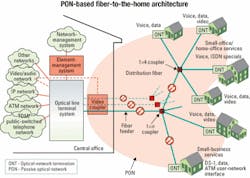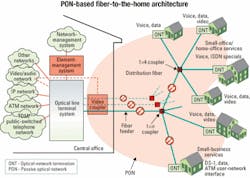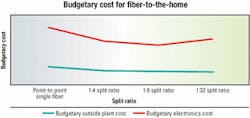Fiber-to-the-home: Is it too expensive?
How much is too much in terms of providing the benefits of limitless speed and capacity to the residential sector?
GEORGE KUBES, Marconi
Most everyone agrees that fiber-to-the-home (FTTH) is the network of the future, but beyond that point, opinions become sharply divided. There are those who believe that an all-fiber architecture to the home is too expensive. They quote target figures of $600 to $1,400 per living unit, insisting the cost is too high an investment for too few revenue-producing services. Others, looking toward the future, see fiber installation as the catalyst to generate new revenue-producing features-services that will require significantly more bandwidth than currently available by using the existing copper network that is limited to about 12 kft for DSL services. If it is believed that video applications and interactive gaming are future revenue-generating services, then the existing copper facilities or digital-loop-carrier (DLC)-based architectures will not be capable of providing enough capacity for these enhanced bandwidth gluttons.
Cost efficiencies have impacted all aspects of the network optical and electronic technologies, optical media, and operational support systems (OSSs). Merge these improved costs with changes in architecture and increased revenue from the DSL market and future services, and FTTH becomes a prime consideration for new installations.
The road to FTTH
Just a few years ago, many service providers investigated various fiber-to-the-curb models. Even with sharing the optical-network unit, cost was excessive due to the increased number of active electronic nodes in the network, the cost of providing primary and emergency power, and the limitation of copper drops to provide service. During the last five years, the cost of components and maintenance of an FTTH system has been steadily declining and the market for broadband services has been increasing. With declining costs for components and changes in the architecture, FTTH becomes a viable choice for new housing, small-business, and rehabilitation applications.
Lasers capable of higher output, greater speeds, and longer life contribute to reducing the cost of the central office (CO) and subscriber electronics. New improvements such as WDM are paving the way to increasing the use of not only new, but also existing optical plant.
The fiber media is another component of the total picture that has experienced a drastic cost reduction. Fiber production has moved from mystical and magical to normal business, whereby fiber is now viewed as a commodity primarily impacted by market demand.
Other impacts to the media cost include major improvements in quality and quantity of fiber splicing. A technician is capable of performing single-to-multiple fusion splices in a matter of minutes in any location, ranging from the splice pit on the rear lot line to the pole in aerial installations. Terminating connectors has significantly improved and is no longer the weak link for high-bandwidth services.
Still more hurdles
One major remaining hurdle is the impact of automated systems to perform bandwidth management, provisioning, and maintenance functions with the new generation of electronic components. For small startup service pro viders, the use of a new generation of element managers is not a major issue.
Element managers for FTTH systems are efficient and self-contained. The difficulty arises when the same system must support and interface with existing legacy systems such as those used by the incumbent local-exchange carrier (ILEC) community. Interfacing with multiple legacy provisioning, record-keeping, surveillance, and the myriad other required systems increases the complexity and generates the need for another layer of management to pull all the inputs together. If there is a weak link in the story, the OSS qualifies.
The impact of architecture to support FTTH deployment has been the largest contributor to reducing cost. The advent of single-fiber passive optical networks (PONs) has made the deployment of fiber a near-term reality. Not only is the cost of materials and number of electronics reduced, but in new-build scenarios, there is virtually no cost penalty for construction of an all-fiber network.
In many areas of the United States, new developments in the range of 2,000 to 6,000 living units are being built, and the existing facilities typically do not support this new growth. Therefore, new or additional fiber plant must be deployed. Through coordination, the cost of trenching and installation of fiber cable can be shared with other utilities when initial services are being deployed. Little, if any, additional cost is incurred for construction, regardless of the media.If transport from the main backbone network to the CO is not available, then fiber, coupled with a SONET multiplexer and DLC, is typically the first choice. Contrast that with using architecture based on a launch platform located at the CO or a remote location, using a PON design. Not only are the distances and number of fibers reduced, but the maintenance associated with active components in the field is also eliminated. Now, there are only two locations for consideration-the node and subscriber unit-reducing the cost and number of electrical components and in time the maintenance and provisioning expense.
Optical splitters
There are multiple scenarios for placement of the passive optical splitters (see Figure 1). Splitter placement and the actual split ratio are dependent on the specific location and number of splitting stages required. It is important to keep in mind that fiber length, quantity of fiber placed, and cost of the splitters are directly related to the location and split ratio.
As depicted in the budgetary cost graph (see Figure 2), the outside plant (OSP) cost, including the splitter, continues to decline until it reaches the 1:8 range. Cost then begins to flatten and may eventually increase, which implies that the higher split ratio of 1:32 is offset by the increased cost of fiber strands required, even if the splitter is located at the traditional feeder/distribution interface point.
The increased number of fibers required from the splitter location erodes the potential cost savings of using a higher-ratio split. This erosion in OSP savings is significantly more pronounced if the splitter is located close to the CO terminal or launch point. As the split point moves closer to the CO, the configuration mimics the point-to-point design, thus an increase in quantity and the cost of fiber is experienced.
Another cost impact is the fill rates of a 1:32 PON, especially if deployed in a slow-growing or overlay configuration. The "breakage" of under-used electronics is greater when the split ratio is higher, thus impacting the deployment business case, particularly when deployed as an overlay to compete with an incumbent service provider.
The split ratio and type of system deployed impact the cost, complexity, and location of the access equipment. The sharing benefit of the common elements continues to reduce the electronic cost until the 1:8 split ratio is achieved. After that point, the increased split ratios impact the quantity of bandwidth provided or require use of technologies such as the G.983 International Telecommunication Union specification for broadband PONs, which are significantly higher in cost and complexity than today's readily available equipment.
The added complexity of an ATM PON significantly increases the cost of the electronic components, the system cost, and the element-management system for provisioning and surveillance systems. Traditional voice traffic must be converted to ATM cells, then reconverted using a voice gateway for access to the existing voice public-switched telephone network. This ATM architecture will likely remain in operation for many more years.
In addition to requiring another costly network element in the voice path of the existing switching network, the complexity of the OSS is greatly increased. Now, the same OSS must not only provide management and surveillance of the access equipment, it must interface with the voice gateway and the switch, using GR-303 interfaces. That requires additional levels of management complexity to provide seamless provisioning and maintenance flow.
Experience shows that the development of a complex provisioning and surveillance system does not come easy, nor is it inexpensive. Additionally, the many "workarounds" required to permit an OSS to work in conjunction with the existing legacy systems adds still another layer of complexity and cost to deployment of G.983 PON systems.
Optimum split ratio
When the total cost for the various split ratios and electronics required for deployment are compared, the optimum cost point is at the 1:8 ratio. This configuration generates additional advantages that translate into lower cost for the service provider:
- It is currently available and capable of supporting bandwidth requirements for high-speed digital service. By using WDM technologies, additional services such as direct broadcast satellite (DBS) or cable television may be provided. These additional revenue-producing services may be added at a later date, depending on the service provider and market served.
- Using existing low-cost subscriber interfaces results in another cost advantage. High-speed Internet access is available with 10-BaseT interfaces, thus reducing the complexity and cost of subscriber interfaces. DBS and cable TV are provided using the currently available set-top boxes.
- Traditional OSP design and engineering procedures directly apply to using the 1:8 split ratio. Splitters may be mounted in traditional locations and inexpensive closures at the lot line with the fiber dropped directly from the pedestal to the customer premises. A technician dispatched on a trouble ticket is able to see the service locations, thus simplifying fault isolation.
- The cost of dispatch and clearing time is significantly reduced. With only two locations containing electronics and the ability of the system to perform self-testing, the correct technician is dispatched to the point of probable failure and service is quickly restored. By dispatching the right technician to the right location, there is reduced clearing time and a significant reduction in maintenance costs.
Additionally, fiber plants require significantly less maintenance than existing copper feeder and distribution designs. This reduced maintenance is a major plus when comparing the overall lifecycle cost of an access infrastructure.
Still, a few basic questions remain to be answered:
- Is FTTH a viable architecture for a particular company? To answer that question, there are multiple modeling tools available to assist in evaluating the needs and market within a particular service area. Taking advantage of these opportunities makes it easy to evaluate the potential of an FTTH network. Combined with knowledge of the market, an informed decision can be made.
- Is a point-to-point or PON architecture the answer to reducing cost and providing services? As illustrated in Figure 2, the currently available split ratio of 1:8 has the best first cost of the four networks considered.
- Is FTTH PON architecture capable of supporting enhanced services and protocols such as ATM and other emerging technologies? Absolutely. FTTH PON architecture has the capability to not only generate additional revenue and provide cost reduction in today's networks, but is also in networks of the future.
George Kubes is manager for network solution planning at Marconi (Pittsburgh). He can be reached via the company's Website, www.marconi.com. Shane Shaneman of Corning Cable Systems also contributed to this article and can be reached via the company's Website, www.corning.com.


